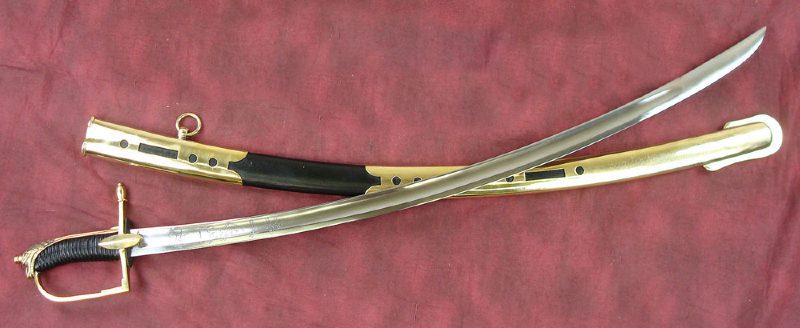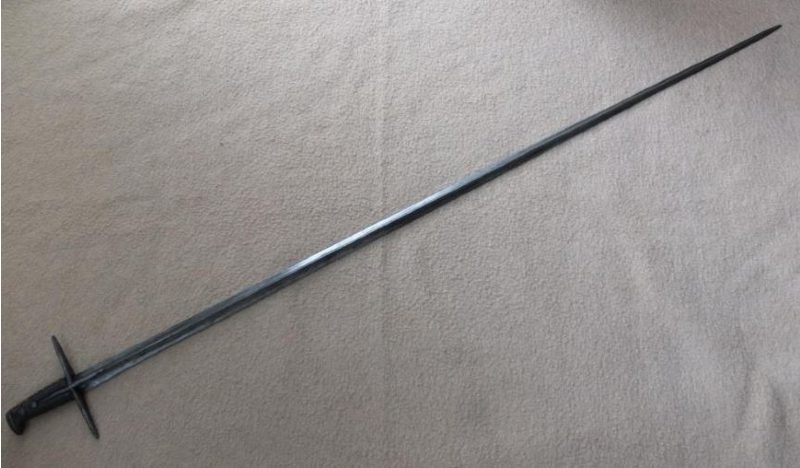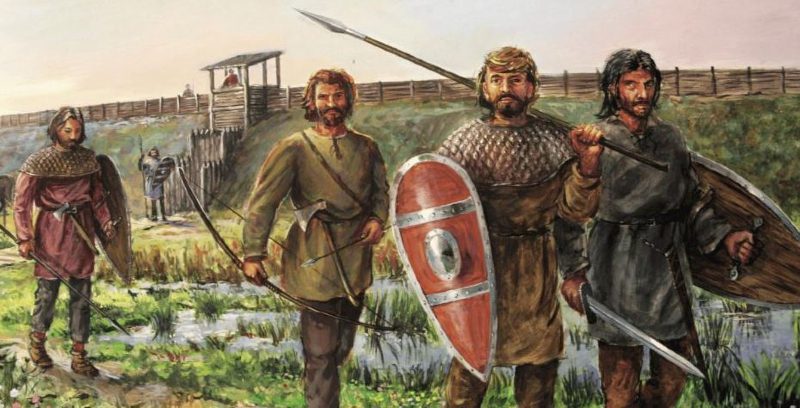10 Russian Swords Types, Characteristics & History
NO AI USED This Article has been written and edited by our team with no help of the AI

Russia is well known for its strong army, huge cannons, and bombs. But did you know that Russia has a long history of swords too?
In this article, we will discuss the Russian sword. First, we will review the most common and popular types of blades. Then we will show the general characteristics and typical traits. Finally, we will review the long history of the Russian sword.
Types of Russian Swords
1. Russian Sabre

The Russian saber, sometimes known as Sablia or Sabiya, is a curved sword produced in Russia and heavily used during the late Middle Ages onwards. The sword was greatly influenced and also mainly bought and brought in from the Turkic, Magyar, Khazar, and Mongol tribes.
The swords were brought in around the 11/12th century, and in time, these swords completely displaced the straight, double-edged swords. So today, when somebody mentions the Russian sword, they usually mean the curved saber-looking sword.
Rus tribes started creating and producing them around the 12/13th century, but only in small quantities since they were expensive to produce.
2. Shashka

The name of the Cossack sword is Shashka. The Shashka is a thin, strong sword with a blade that is straight enough to be good for thrusting and curved enough to be great for cutting and slashing. The Shashka looks like a cross between a straight sword and a full Russian saber.
Its name comes from an Adyghe word that means “long knife.” Most of the time, this sword has a single, very sharp edge and is used with one hand. It is a guardless sword, which means that when it is not in use, the blade is completely hidden in its wooden scabbard. Only the big, curved pommel and decorated hilt are visible.
During the 19th century, the Shashka was used a lot. It eventually replaced the regular saber across almost all Russian cavalry units, except for the hussars. By 1881, all Russian troops and authorities used Shashkas as their official weapon.
3. Russian Cossack Shash

Cossacks used the Cossack saber, sometimes known as Shasqua, which is a modified version of the Shashka. It was used as early as the 17th century, and Russian soviet troops even used it during World War II. It is thin, light, and has a simpler grip. Russia is one of the few places where swords are used in national dance. The Cossack Shashka sword is a part of this tradition.
It is slightly shorter than the regular Caucasian Russian saber but much lighter.
4. Russian Viking Straight Sword

The Russian Viking straight sword was the first sword used in the Rus tribes. It was brought over by the Vikings of the Rurikid dynasty that started spreading quickly across the tribes. The sword was mostly used by nobility as it was an expensive weapon to own. It is ‘the’ medieval sword of early Russia.
It is roughly 3.2 feet (1 meter) long and has a two-edged blade that ends in a very sharp point. It resembles the Viking sword in almost every way, except for the Slavic ornaments found on the blade, handle and guard.
While the original didn’t come from Russia (but was brought to those lands), Rus tribes made small amounts of them. So if you find one available online, you can be sure it is a Russian sword.
5. Russian Arming/Norman Sword

This type of Russian sword comes mainly from the West (Europe). It is the transitional hybrid sword between the Russian Viking straight sword and the Arming sword.
Both in Eastern and Western Europe, people favored Armings words. So if you see a straight Russian arming sword available online, you may know that it is real. However, it needs to have some Russian Slavic ornaments.
In general, the blades of Norman swords are longer than the Viking swords. This is because they greatly improved their technology over time and lasted much longer.
6. Palash or Dragoon Sabre

The Palash is the Russian heavy cavalry sword. It is a straight sword with a very long, wide blade. At first, they had two edges, but as time passed, they only had one. In addition, it had a hole running along the blade’s length.
The Palash was also different because the grip was curved and had no pommel. But the guard was shut. The sword was built after the 16th century. It was often carried in a scabbard attached to the left side of the saddle instead of worn by the warrior.
The name of the weapon comes from the Turkish sword, pala. Peter the Great gave this kind of sword to the new dragoon units he made. To gather enough swords, he imported them from other countries but also made them in Russia. It was a heavily used cavalryman’s sword during the 18th and 19th centuries.
The grip on the dragoon Palash was curved. The officer model’s handle looked like a basket. There was also a shorter version used by the navy. The blade of the Palash was 33 inches (84.5 cm) long and 1.7 inches (4.5 cm) wide.
7. Konchar

The long Russian rapier-style sword is called the Konchar, also called an Akoncher or a Konchal. It has a long, straight blade with a very sharp point. It has three or four sides, giving it a diamond shape. It was very similar to the rapier sword used in the West.
It worked well for piercing through mail with a thrust. The first mention of the Konchar was at the Battle of Kulikovo in 1380, but it was probably made before then. It was used more often in the 1600s until Peter the Great replaced it with the Shpaga.
The first Konchars reached up to 4.2 feet (130 cm). Over time, the shape improved, and the blade became 5.2 feet (160 cm) long. Some can get up to 5.9 feet (185 cm).
It does not have many uses as the rapiers had in duels inside the heart of Europe. Still, it is a very interesting Russian sword that is less familiar.
8. Shpaga

The Shpaga has a blade of at least 3.2 feet (one meter) long and is thin and straight. The blade can have a single edge, two edges, or a cross-section with many angles. The knuckle bow and guard on the Shpaga’s handle, or hilt, can be made in different ways.
One type of Shpaga is the foil, which is shorter than a regular Shpaga and has a guard that looks like a cup and a blade with a cross-section that looks like a number of triangles.
The Shpaga was the weapon of Russian nobility. It was used sometimes in battles when commanding many troops, but most of the time, it was just for appearance. It is basically the officer sword of the Russian cavalry.
9. Kinjal

The Kindjal is a short, two-sided sword that was occasionally combined with the shashka or saber. It was and remained such an important part of Russian military heritage that it was included as part of the uniform. That is why it was mostly kept in scabbards and used for ceremonial purposes.
The short, straight, double-bladed kindjal blade has a viciously sharp point. A groove runs along the blade from the handle almost all the way to the tip. The groove can be right in the middle, off-center, or have two paths.
Many Russian Kinjal swords/daggers are straight, while others are curved.
10. Kladenets Sword

The Kladenets sword is a magical sword most often mentioned in Russian fairy tales or various types of mythical stories. Its most commonly used in historical Russian folklore and simply described as a ‘magical sword.’
They appear in most Slavic folklore legends and have some historical traces, but they are not from real events.
General Characteristics of a Russian Sword

Rus medieval tribes mostly used axes and spears because they were much easier to create. They also had straight, double-edged blades, but the general appearance of a Russian sword is that of the saber.
- Blade: The blade of the Russian sword is usually one-edged and curved, resembling the Turko-Magyar-Mongol sabers. The Russian blade length is usually around 2.6 feet (80 cm) long and is mostly used by the Russian cavalry and the Cossacks for slashing strikes when on horseback. Many of the blades have writings on them or are made from Damascus steel.
- Guard: The most common guard for the Russian sword is closed or doesn’t have a guard. If you look at the traditional Russian saber, you may notice that it is closed. However, Shaskhas do not have a guard.
- Handle: The handle of the Russian sword is very short. It is usually around 4 to 5.9 inches (10 to 15 cm). If a Russian saber is heavily ornate, it is meant for ceremonies. But if it is for a Shashka, it is usually plain, allowing for a better and stronger grip. Some Russian sword handles are curved, while others are straight.
- Scabbard: Russian scabbards are characterized by how well-decorated they are. This is mainly because only the wealthy and nobility had swords. As a result, they can be decorated with gold, making them heavier than usual. Wood is usually used for making a Russian scabbard.
- Length: The usual length of a Russian sword is about 3.2 feet (one meter). This makes it the ideal size for both slashing and thrusting. The cavalry mostly used the Russian sword for slashing.
- Weight: The weight of the Russian swords may vary. The casual and most used Russian saber will be around 2.8 lbs (1.3 kg), while the Cossack Shashka can be around 1.3 lbs (600 grams)! So, they were light swords that were mostly used one-handed.
History of Russian Swords

When talking about Russian swords, one may note that the Russian sword is the Shashka or the saber. This might seem as though East Slavs (including Rus tribes) didn’t use swords before the curved ones. They did, however, but it was rare.
The sword was used mainly by the rich and powerful. Based on how many battle axes, spears, and swords have been found, there were probably at least ten axes and six spears for every sword. In addition to axes and spears, maces, flails, and sabers were also used. Sabers were seldom found in Russia – about as many as swords.
Straight Swords

If you ask, “What was the Russian sword in the Middle Ages?” you might get a short answer that you might not expect: – It didn’t exist. The Russians did use swords, but for most of the early Middle Ages, spears, axes, and bows were the Slav’s main weapons. Then, in the ninth century, the Vikings introduced the sword to Russia.
Archaeologists have found hundreds of old Russian swords called “Viking swords” or “Carolingian swords“. Most of the time, it’s not about copying common shapes of swords. Instead, they were bought directly from the Franks (Germans), as shown by the marks left behind, which are like a trademark.
Ulfberh and Ingelrii were the most common sword brands in Russia. Even though these swords are called “Viking swords,” the Scandinavians, like Russia, bought their blades from the Germans.
Sabres

Around the 10th and 11th centuries, east Slavic tribes around Kyiv started using the saber, which was heavily influenced and obtained from the Khazar-Magyar weapons.
The saber was the sword weapon of choice, but the spear and axes were more commonly used. This is because the creation of a sword takes a lot of resources and is much more expensive than spears, for example.
When the Cossacks became Russia’s most effective and powerful troops, the cavalry and horses were the main force of power. That is why the curved saber eventually became the most used sword in Russia.
To this day, swords in Russia aren’t shown off as much as the Russian cannons or artillery that they developed.




